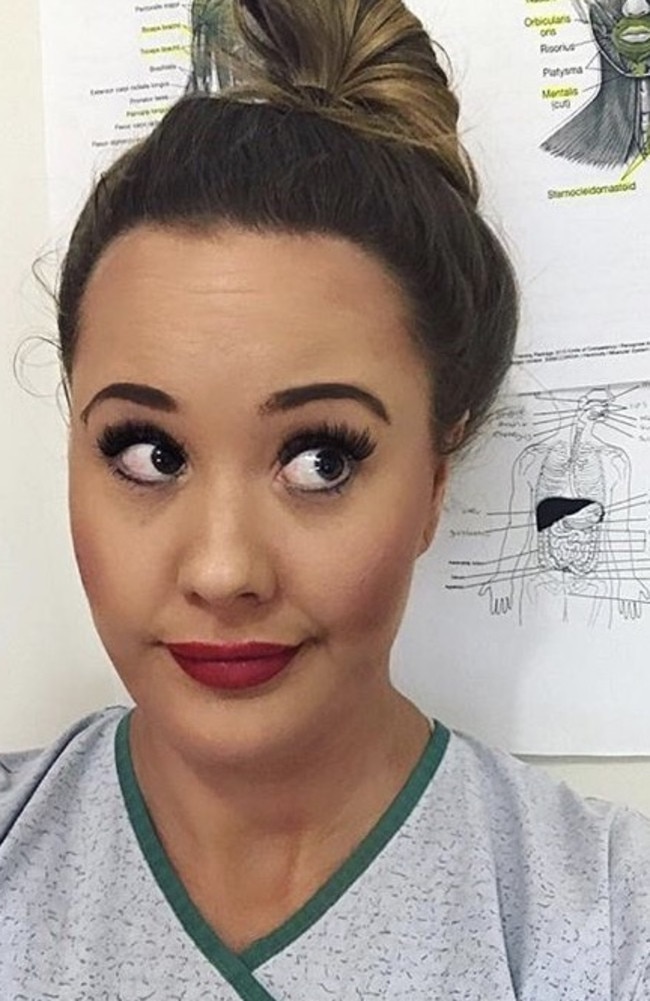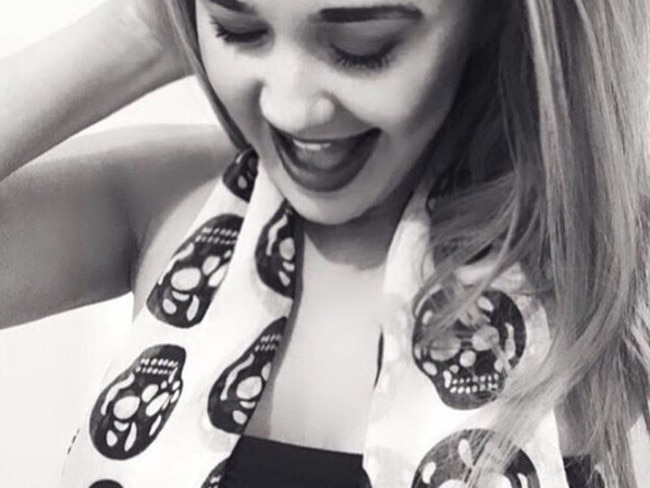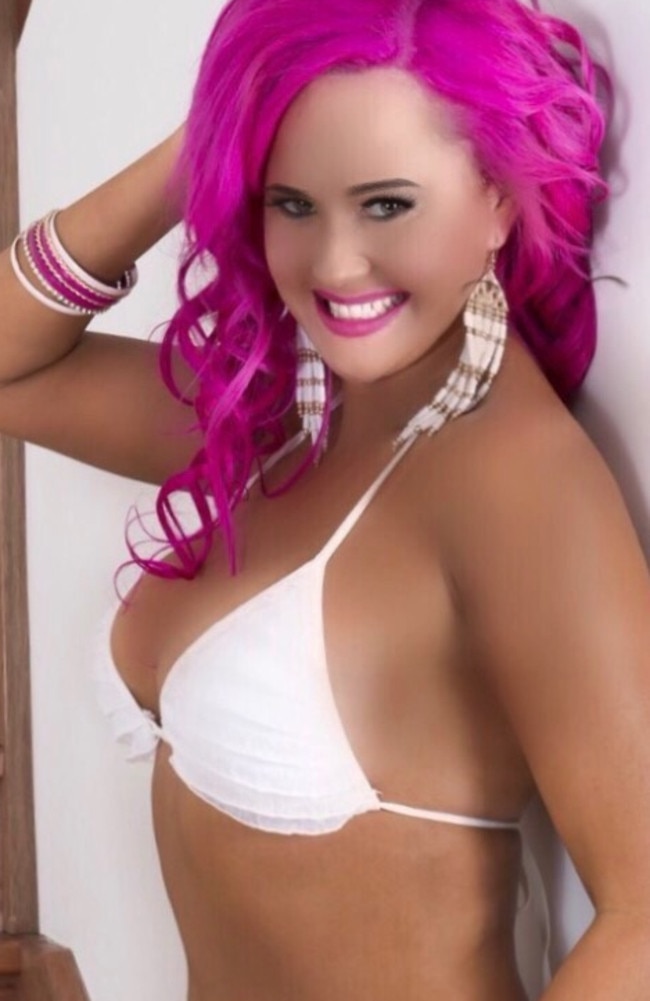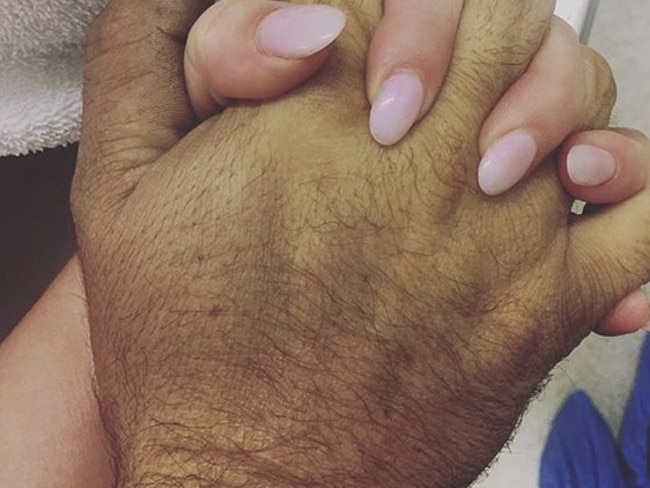Heels and hearses: Australia’s most outrageous mortician
SHE’S a glamorous part-time bikini model who’s wanted to work in a funeral home since she watched My Girl as a child. And her stories are deadly.
MEET Australia’s most outrageous mortician, a glamorous part-time bartender and bikini model who wanted to work with the dead since she watched black comedy classics My Girl and Death Becomes Her as a child.
Brisbane’s Emma Jane Holmes wants to break the taboos around our mortality, insisting her job is both uplifting and at times excruciatingly funny.
There was the night the 33-year-old and her on-call colleagues accidentally picked up the wrong body, for example. “I’d had no sleep, we’d done four or five (pick-ups) and it was 3am,” she told news.com.au. “This nursing home had three or four people in the room, and this person looked like he’d passed away. So we put on the wrist tags and so on, and he suddenly started snoring and jerking around. There was a little pair of art scissors nearby so we quickly cut them all off.”


The anecdotes she shares on her blog, Heels and Hearses, sound like something out of a sitcom, but Emma Jane says she’s not always sure what reaction she’ll get if she reveals what she does. “It’s such a rewarding job, but you’re faced with so many grim situations, sometimes you’ve got to laugh,” she says. “It’s not all doom and gloom.
“People either freak out or are genuinely interested. You have to be careful, it’s a sensitive subject.
“I live with death 24/7. I enjoy teaching people what happens.”
The former beautician says her favourite part of the job is the “transfer”, when the team goes out to pick up bodies, because “you never know what you’re going to see.”
There was the old man who asked if they could wait until he fell asleep to take his wife away. She and her colleagues called the office for agreement and then waited until he dropped off, gently sliding his wife out of the bed so they didn’t wake him. On another occasion, they picked up a wealthy man who had paid for his whole family to go to the Maldives and then died while they were away. “There are so many ying-yang moments,” she says. “It’s a privilege to work with these people.”
Back in the funeral parlour, Emma Jane has a “death wardrobe” filled with clothing and items people supply to be buried with their loved ones, from letters to a fishing rod to the ashes of a freshly cremated pet.


“We’ve been in the mortuary fake-tanning a lady who worked in a bar and had big, blue hair. I had a box and was dyeing her hair,” she says. “It’s the story of their life. We treat every person exactly the same, even if they’re decomposing and falling apart, the same as if they’re 21 with beautiful skin.”
After a hot shower to relieve the rigor mortis and make the corpse “more lifelike”, the morticians suture the mouth shut with a needle and thread, apply creams and insert plastic eye caps to keep the eyes closed. If the deceased is particularly elderly and dehydrated, the team might create some fake teeth to stop the mouth sinking in.
Emma Jane has seen some bodies in disturbing states over the ten years she’s been in the business — after accidents, murders and autopsies. “When you first see them from the coroner, it can be quite a jolt,” she says. “They’re scientists, they want to find out what happened and make sure the family has answers. Our (job) is to make sure the family has a beautiful funeral. We don’t want any blood in the hair. We’ve been trained, if the suture isn’t perfect, we fix it.
“We clean out the body cavity with embalming fluid. We’ll quite often retrieve the brain from the skull. It was such a profound moment when I held a brain for the first time.”


The young funeral director and mortician has encountered some high-profile dead people over the years, including a six-year-old girl allegedly strangled to death by her father. The saddest moments for her involve children — she was particularly shaken after picking up an eight-year-old who had choked on calamari and when lifting a dead baby from a hysterical mother’s arms.
“We go and debrief with a coffee and try to perk up. Counselling is available, but I believe people in the funeral industry are meant to be there. People doing this job are strong enough and have coping mechanisms. I look on the bright side and try to be grateful... It sounds corny but I think, I get to hug my family and friends.
“I want people to realise it’s not taboo or scary, it’s inevitable. Once you’ve faced it, acknowledged it, you’re more aware of your life.”
Since building up a following on her blog, Emma Jane has signed a deal to publish a book in 2019. “There are so many misconceptions,” she says. “I heard a story on the radio about a funeral director and it was so grim. I don’t wear a black suit and hide in the mortuary on the weekend. I wear heels. The girls I work with are normal beach babes, the guys go and drink after work.
“Every funeral director I’ve known has not only been a profound teacher, but one of the coolest people I’ve ever met. Some are rock band members, professional surfers and ex-navy soldiers. They head to the gym after parking up the hearse for the day, grab a drink after nailing the lid on a coffin and hit the dance floor at a club after fixing a corpse’s hair. We are just normal everyday people.”
Emma Jane hopes her book will expose the reality of the two worlds she straddles, waitressing at celebrity parties at the weekend, and standing beside tables with a man’s body parts spread across them the next day. “We stitched him back up and in the end, he was able to be viewed,” she says of that motorbike accident victim. “The lady I worked with, she’s an artist. We had a man jump off a building, his head fell apart in my hands, and she made him look normal. She’s just incredible.”
EMMA JANE’S FIVE MYTHBUSTING FACTS ABOUT FUNERAL HOMES
1. There are so many misconceptions about the funeral industry — dark morgues with organs floating about in jars of bubbly mysterious liquid, creepy guys with a hunchback pulling skulls apart under dim light. Let me shed some light for you … There’s plenty of it! The funeral home is bright and there are no bats hiding in the corners of the mortuary ceiling.
2. Despite preconceptions about extortionate costs, a funeral industry worker does not earn a huge amount, so a single girl living in the city finds it terribly hard to survive on the wage. That’s why on weekends, I swap my funeral director’s suit for heels and a drinks tray, waitressing in pubs and clubs to supplement my income.
3. Good morticians really care about your loved-one’s appearance. Many spend years studying and practising the preparation of the deceased to create the perfect appearance for a farewell, from massaging rigor mortis from muscles to the mouth suture. The deceased are cared for like babies. There is no breaking of bones.
4. You don’t always need a funeral. An NSNA (No Service, No Attendance) is very common. The body is prepared just like one destined for a grand inner-city cathedral with bagpipes and a procession. After prep, the body is placed in the coffin and a “run out” takes place, where the hearse driver take the body to the crematory. No funeral takes place, saving loads of money and a whole lot of fuss.
5. Had an autopsy? Your brain won’t get left behind! Sometimes certain organs will be required for further analysis, but a funeral of the body will still take place. Once the organ is released from testing, it will be collected by the funeral home and can be cremated for the family.
Leave a comment below, or share your story with emma.reynolds@news.com.au or @emmareyn.



